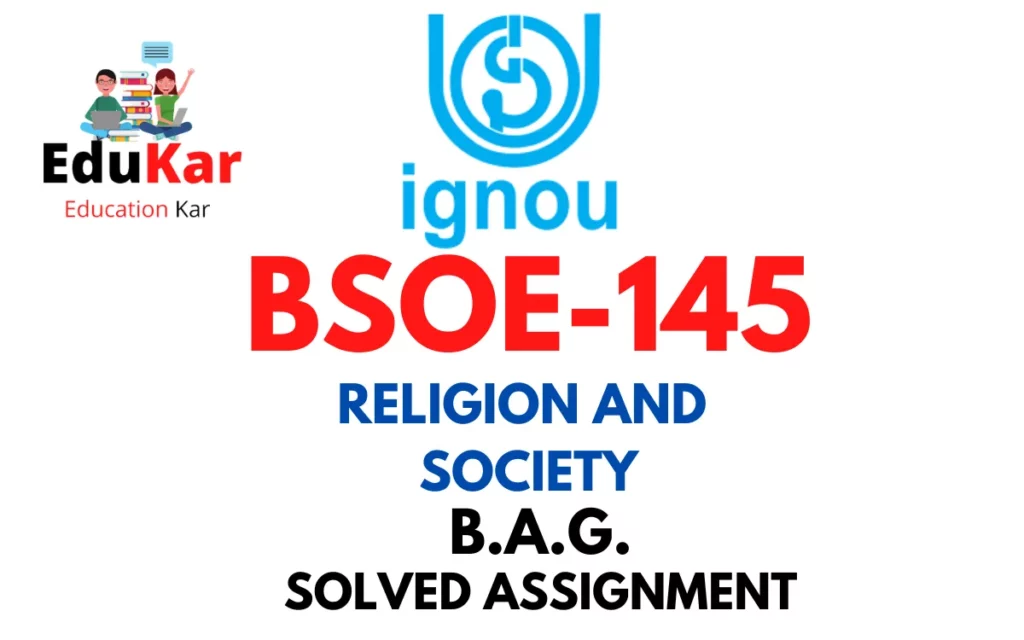Contents
- 1 Assignment One
- 2 Answer the following Descriptive Category questions in about 500 words each. Each question carries 20 marks.
- 3 1. Discuss the contributions of Simmel and Veblen on economic sociology.
- 4 Explain the concepts of embeddedness and substantive economy.
- 5 2. Discuss the sociological concept of rationality and economic behaviour.
- 6 Examine the primary modes of economy for hunting and gathering societies.
- 7 Assignment Two
- 8 Answer the following Middle Category questions in about 250 words each. Each question carries 10 marks
- 9 3. Distinguish between development from the top and development from the bottom.
- 10 Discuss the concept of gift.
- 11 4. Describe the pre-requisites of socialism.
- 12 Differentiate between traditional and advanced horticulture.
- 13 5. Examine the dimensions of capitalism.
- 14 Discuss the economic mode of peasant societies.
- 15 Assignment Three
- 16 Answer the following Short Category questions in about 100 words each. Each question carries 6 marks.
- 17 6. What is formalism in economic sociology?
- 18 7. What is Olericulture?
- 19 8. What is feudal mode of production?
- 20 9. What is the medium of exchange in agricultural societies?
- 21 10. Describe the demerits of globalization.

| Title | IGNOU: BSOG-176 Solved Assignment 2022-2023 (ECONOMY AND SOCIETY) |
| University | IGNOU |
| Degree | Bachelor Degree Programme |
| Course Code | BSOG-176 |
| Course Name | ECONOMY AND SOCIETY |
| Programme Name | Bachelor of Arts (General) |
| Programme Code | BAG |
| Total Marks | 100 |
| Year | 2022-2023 |
| Language | English |
| Assignment Code | ASST /TMA /July 2022-23 |
| Last Date for Submission of Assignment: | For June Examination: 31st March For December Examination: 30th September |

Assignment One
Answer the following Descriptive Category questions in about 500 words each. Each question carries 20 marks.
1. Discuss the contributions of Simmel and Veblen on economic sociology.
Ans: Georg Simmel and Thorstein Veblen were two of the pioneering sociologists who greatly influenced the development of economic sociology. Both of them made significant contributions to the study of economics and society, and their works continue to be relevant even today.
Simmel, a German sociologist, philosopher, and cultural critic, is considered one of the founding fathers of sociology. He made important contributions to the study of urbanization, money, and fashion, among other things. Simmel’s most significant contribution to economic sociology was his conceptualization of money as a social phenomenon. He argued that money was not simply a means of exchange but also a symbol of social status and power. He also emphasized the role of money in shaping social relationships, especially in the context of urbanization.
Veblen, an American sociologist and economist, was a critic of the prevailing economic theories of his time. He is best known for his theory of conspicuous consumption, which refers to the tendency of individuals to purchase goods and services not for their utility but for their social status and prestige. Veblen argued that the upper classes engage in conspicuous consumption to distinguish themselves from the lower classes, and that this behavior has significant social and economic consequences.
Veblen’s contributions to economic sociology are numerous and wide-ranging. He was one of the first to examine the social and cultural aspects of economic behavior and to critique the dominant economic theories of his time. He is also known for his theory of institutional economics, which focuses on the role of cultural norms, beliefs, and values in shaping economic behavior. Veblen’s works have had a lasting impact on the study of economics and society, and his ideas continue to influence contemporary debates in the field.
OR
Explain the concepts of embeddedness and substantive economy.
Ans: Embeddedness and substantive economy are two interrelated concepts in economic sociology that have gained significant attention in the field. These concepts provide an alternative perspective on economic activity that goes beyond the traditional neoclassical view of economics as a self-contained and autonomous system.
Embeddedness refers to the idea that economic activity is embedded in social, cultural, and institutional contexts, rather than existing in a vacuum. This means that economic behavior is not solely determined by market forces, but also shaped by social norms, beliefs, and values, as well as political and legal institutions. Embeddedness highlights the interconnectedness of economic and non-economic systems, and the role of social and cultural factors in shaping economic behavior.
Substantive economy, on the other hand, refers to the set of social and cultural values and beliefs that underlie economic activity. These values and beliefs determine what is considered to be a good or a bad economic outcome, and provide a framework for evaluating the morality and ethics of economic activity. Substantive economy is concerned with the underlying values that drive economic behavior, and provides a means for evaluating the social and cultural consequences of economic activity.
One of the key contributions of the concepts of embeddedness and substantive economy is that they provide a more nuanced understanding of economic activity. They challenge the traditional view of economics as a self-contained system and highlight the interdependence of economic and non-economic systems. This interdependence has important implications for the study of economics and society, as it suggests that the economy cannot be understood in isolation from the broader social and cultural context in which it operates.
Additionally, the concepts of embeddedness and substantive economy have important implications for public policy and economic decision-making. They suggest that economic policies should take into account the social and cultural context in which they operate, and that economic outcomes should be evaluated not only in terms of their efficiency, but also in terms of their social and cultural consequences. This can lead to a more equitable and sustainable economic system, one that is better aligned with social and cultural values.
2. Discuss the sociological concept of rationality and economic behaviour.
Ans:
Rationality is a central concept in both sociology and economics, and has been widely debated and discussed in both disciplines. In sociology, rationality refers to the cognitive processes and decision-making strategies used by individuals in navigating the social world. In economics, rationality is a key assumption of many economic theories, and refers to the idea that individuals make decisions based on self-interest and a rational calculation of costs and benefits.
In the field of economic sociology, the concept of rationality has been used to understand and explain a variety of economic behaviors, from consumer behavior to financial decision-making. One of the key debates in the field is the extent to which individuals make rational decisions in the economy, and the factors that influence these decisions.
Some sociologists argue that individuals are not always rational in their economic behavior, and that other factors, such as emotions, social norms, and cultural values, play a significant role in shaping economic behavior. For example, research has shown that individuals are often influenced by social norms and expectations when making economic decisions, and that emotions, such as anxiety and greed, can play a significant role in financial decision-making.
On the other hand, some economists argue that individuals are highly rational in their economic behavior, and that deviations from rationality can be explained by factors such as incomplete information or bounded rationality. Bounded rationality refers to the idea that individuals make decisions based on limited information and cognitive capacities, rather than on a complete calculation of costs and benefits.
In recent years, there has been a growing body of research in the field of behavioral economics that challenges the traditional view of rationality in economics. This research argues that individuals often make decisions based on heuristics, or mental shortcuts, rather than on a rational calculation of costs and benefits. This research has important implications for our understanding of economic behavior, as it suggests that individuals are not always rational in their decision-making, and that other factors, such as emotions, social norms, and cultural values, play a significant role in shaping economic behavior.
OR
Examine the primary modes of economy for hunting and gathering societies.
Ans: Hunting and gathering societies are the earliest forms of human social organization, and they exist even today in some parts of the world. These societies are based on a subsistence economy, where people hunt and gather food and other resources to meet their basic needs. The primary mode of economy for hunting and gathering societies is communal ownership and sharing.
One of the key features of hunting and gathering economies is the communal ownership of resources. Hunting and gathering communities do not have private property, and all resources are shared among members of the community. This mode of economy is based on the principle of reciprocity, where members of the community exchange goods and services with each other.
Another feature of hunting and gathering economies is the absence of a formal system of exchange. People in these societies exchange goods and services based on mutual need and trust, rather than on formal contracts or agreements. This mode of exchange is known as “gift economy” and is based on the principle of generosity and trust between members of the community.
Hunting and gathering societies also have a strong sense of community and social cooperation. Members of the community work together to gather resources and provide for their basic needs. This mode of cooperation is essential for survival in these societies, as individuals cannot provide for themselves in isolation.
In addition to hunting and gathering, some hunting and gathering societies also engage in simple forms of agriculture and animal husbandry. This mode of subsistence economy is called “mixed economy,” where people rely on a combination of hunting, gathering, and farming to meet their needs. In these societies, people work together to cultivate crops and raise animals, and the produce is shared among members of the community.
However, the primary mode of subsistence economy for hunting and gathering societies remains hunting and gathering. These societies have a deep understanding of their environment and are experts at finding and utilizing a wide range of food and other resources from their surroundings. They also have a rich cultural heritage and a deep connection to their ancestral land and resources.
Assignment Two
Answer the following Middle Category questions in about 250 words each. Each question carries 10 marks
3. Distinguish between development from the top and development from the bottom.
Ans: Development from the top refers to a top-down approach to economic and social development, where decisions and policies are made by central authorities and implemented through bureaucratic channels. The focus is on modernization and industrialization, with a view to boosting economic growth and improving the standard of living for all. The key features of this approach are state intervention and control, and a reliance on a centralized planning system. This approach is often associated with command economies and state-led development models.
On the other hand, development from the bottom, also known as bottom-up development, is an approach that places emphasis on the needs and potential of local communities and individuals. In this approach, development is seen as a process driven by the participation of all members of society, and the focus is on empowering communities to take control of their own development. The key features of this approach are community involvement, self-help and empowerment, and the development of local capacities and resources. This approach is often associated with decentralized planning and community-led development models.
The distinction between the two approaches is important because it highlights the different perspectives and priorities that guide development. While development from the top may bring about rapid economic growth and improvements in infrastructure, it may also lead to a lack of local ownership and control, and an unequal distribution of benefits. On the other hand, development from the bottom may take longer to achieve its goals, but it is more likely to be sustainable, equitable and inclusive.
OR
Discuss the concept of gift.
Ans: The concept of gift refers to the exchange of non-economic goods or services between individuals or groups. It is a fundamental aspect of social and economic relationships and has been studied in a range of disciplines, including anthropology, sociology, and economics.
A gift is distinct from a sale or trade transaction in that it is not motivated by self-interest or the expectation of an equivalent return. Instead, gifts are given freely and voluntarily, often as a means of building or strengthening social bonds and relationships. The act of giving a gift is typically accompanied by a sense of obligation on the part of the recipient to reciprocate the gesture in some way.
Gift-giving is a widespread cultural practice and can take many different forms. In some cultures, gift-giving is an important part of social rituals and celebrations, such as birthdays, weddings, and religious festivals. In other cultures, gifts are given to mark significant events, such as a promotion at work or the birth of a child. Gifts can range from simple, practical items to more extravagant and symbolic gifts.
The concept of gift has significant implications for economic and social relationships. For example, the practice of gift-giving can serve to reinforce social hierarchies and power dynamics, such as when gifts are given to superiors in the workplace as a way of maintaining good relationships. On the other hand, gift-giving can also serve to build trust and foster social cohesion, particularly in communities where gifts are exchanged freely and reciprocally.
Ans: Socialism is a political and economic ideology that seeks to establish a more equal and just society by redistributing wealth and resources and empowering workers. While the precise definition of socialism and the policies it entails may vary depending on the context, there are certain prerequisites that are commonly considered essential for the establishment of a socialist society.
The first prerequisite of socialism is a strong sense of community and collective ownership. This means that individuals must be willing to work together for the benefit of the whole, rather than solely pursuing their own self-interest. A culture of cooperation and mutual aid is therefore crucial for the success of socialism.
Second, there must be a commitment to social and economic equality. Socialism aims to reduce inequality by redistributing wealth and resources, and this requires a willingness on the part of society to ensure that everyone has access to the resources they need to live a decent life. This may involve policies such as progressive taxation, a minimum wage, and access to education and health care.
Third, there must be a strong sense of democracy and political participation. Socialism involves the collective ownership and control of the means of production, and this requires a system of democratic decision-making to ensure that everyone has a say in how the economy is run. This may involve the establishment of worker-owned cooperatives, the election of representatives to manage the economy, or some combination of these approaches.
Fourth, there must be a well-functioning infrastructure and supportive institutions to ensure that the goals of socialism can be achieved. This includes institutions such as schools, hospitals, and banks, as well as infrastructure such as roads, communications networks, and energy systems.
OR
Differentiate between traditional and advanced horticulture.
Ans: Horticulture is the study and practice of cultivating plants and producing food and other products. It is a complex field that has evolved over time, and there are two main types of horticulture: traditional horticulture and advanced horticulture.
Traditional horticulture refers to the cultivation of plants using traditional methods and techniques. This type of horticulture is often practiced in rural areas, where people rely on their own knowledge and experience to grow crops. Traditional horticulture typically involves low-tech equipment, such as hand-held tools, and is characterized by the use of natural inputs, such as compost and animal manure, for fertilizing the soil. The crops grown in traditional horticulture are often used for subsistence purposes, or for sale at local markets.
In contrast, advanced horticulture involves the use of modern technology and techniques to improve the efficiency and productivity of crop production. This type of horticulture is often practiced in urban areas and on large-scale commercial farms. Advanced horticulture typically uses high-tech equipment, such as greenhouse structures, hydroponic systems, and precision irrigation systems. The crops grown in advanced horticulture are often used for large-scale commercial purposes, such as for export or for sale in supermarkets.
There are several key differences between traditional and advanced horticulture. One of the main differences is the level of technology and inputs used. Traditional horticulture relies on low-tech equipment and natural inputs, while advanced horticulture uses high-tech equipment and chemical inputs. Another key difference is the scale of production. Traditional horticulture is often practiced on a small scale, while advanced horticulture is practiced on a large scale. Finally, there are differences in the end-uses of the crops produced. Traditional horticulture is often used for subsistence or local markets, while advanced horticulture is used for commercial purposes.
5. Examine the dimensions of capitalism.
Ans: Capitalism is a political and economic system characterized by private ownership of the means of production, the creation of goods and services for profit, and a market economy. It is one of the most dominant economic systems in the world today and has been the subject of much debate and discussion. There are several dimensions to capitalism that are worth examining.
First, there is the dimension of ownership. Capitalism is based on the idea of private ownership of the means of production, meaning that individuals and corporations own and control the factories, land, and resources used to produce goods and services. This private ownership provides the incentive for people to invest and create new businesses, and it also provides a source of profit that can be used to further expand the economy.
Second, there is the dimension of competition. Capitalism is characterized by competition between businesses, which drives innovation and efficiency. Businesses must compete with each other to attract customers and earn profits, and this competition can lead to lower prices, higher quality products, and greater choice for consumers. However, competition can also lead to monopolies and other forms of market power that can limit competition and restrict consumer choice.
Third, there is the dimension of the market economy. Capitalism is based on the idea that the market, rather than the government, should determine the allocation of resources and the prices of goods and services. This means that prices are set by supply and demand, and businesses must respond to market forces if they are to be successful. The market economy can lead to economic growth and prosperity, but it can also lead to instability, income inequality, and other forms of economic distress.
Fourth, there is the dimension of regulation. Capitalism is often associated with a minimal role for the government, but in practice, most capitalist economies are heavily regulated. Governments regulate business behavior and protect consumers through laws, regulations, and other forms of intervention. This regulation can help to prevent market power and promote economic stability, but it can also limit the freedom of businesses and consumers.
OR
Discuss the economic mode of peasant societies.
Ans: Peasant societies are characterized by small-scale agriculture and a rural way of life, and their economic mode of production is an important aspect of their social and cultural identity. The economic mode of peasant societies can be described as subsistence-oriented, communal, and based on a combination of family labor and small-scale market exchange.
In peasant societies, the main mode of production is agriculture, and the focus is on producing enough food and other basic necessities to meet the needs of the community. This subsistence-oriented approach means that the primary goal of agriculture is to provide for the basic needs of the people, rather than to generate a profit for individuals or corporations. The production of crops and livestock is often carried out by family members using traditional methods, and the produce is often shared within the community.
Peasant societies are typically organized around a communal system, where resources and land are held in common and are managed by the community as a whole. This communal system is based on a sense of mutual cooperation and support, and it provides a safety net for families and individuals during times of hardship. In some cases, the communal system is organized through a system of collective farming, where groups of families work together to produce crops and livestock.
Peasant societies also have a small-scale market economy, where goods and services are exchanged for money or other goods and services. This market exchange allows for the exchange of surplus production and the acquisition of goods and services that are not available within the community. The market economy in peasant societies is often limited in scope, and it does not play a dominant role in the lives of the people.
Assignment Three
Answer the following Short Category questions in about 100 words each. Each question carries 6 marks.
6. What is formalism in economic sociology?
Ans: Formalism in economic sociology refers to the use of mathematical models and formal theories to analyze and explain economic behavior and relationships. This approach seeks to identify and understand the underlying rules, patterns, and structures that govern economic interactions and transactions.
Formalism in economic sociology is often used to analyze complex economic phenomena, such as market structures, pricing mechanisms, and decision-making processes. By using mathematical models and formal theories, economists and sociologists can identify and analyze relationships between variables, test hypotheses, and make predictions about economic behavior.
One of the key features of formalism in economic sociology is its emphasis on the use of quantitative methods and empirical data. This approach seeks to test theories and models using data, and to use this data to validate or falsify hypotheses.
7. What is Olericulture?
Ans: Olericulture is a branch of horticulture that deals with the cultivation of vegetables and edible plants. This field of study encompasses a wide range of crops, including leafy greens, root vegetables, legumes, and fruiting vegetables such as tomatoes and cucumbers.
Olericulturists are responsible for developing and implementing sustainable growing practices, from seed selection and planting to harvest and post-harvest handling. They work to increase yield, improve crop quality, and reduce pest and disease problems.
The goal of olericulture is to produce healthy, nutritious, and safe food while minimizing the impact on the environment. This requires a thorough understanding of plant physiology, soil science, entomology, plant pathology, and other related disciplines.
Olericulture is an important field of study for those involved in agriculture and food production, as it helps to ensure that the world’s growing population has access to adequate and nutritious food. By developing sustainable growing practices, olericulturists play a vital role in ensuring the future of food production.
8. What is feudal mode of production?
Ans: The feudal mode of production refers to the social, economic, and political system that existed in Europe from the 9th to the 15th centuries. The feudal mode of production was characterized by the dominance of landed property and the close relationships between lords and serfs.
In the feudal system, lords owned large estates and the land was worked by serfs, who were bound to the land and owed loyalty and labor to their lords. The lords provided protection and other services to the serfs in exchange for their labor and produce.
The feudal mode of production was based on the personal relationships between lords and serfs and was organized around the manor, a self-sufficient unit of production. The manor was the center of economic, social, and political life in feudal society and was often isolated from the larger world.
The feudal mode of production was eventually replaced by the capitalist mode of production during the Renaissance and the Enlightenment. The growth of trade, commerce, and industry led to the development of new social and economic relationships, and the feudal system was gradually replaced by a system based on wage labor and private property.
9. What is the medium of exchange in agricultural societies?
Ans: In agricultural societies, the medium of exchange refers to the means by which goods and services are exchanged between individuals and communities. The medium of exchange can take various forms, including barter, currency, and credit.
Barter refers to the direct exchange of goods and services without the use of money. This was the earliest form of medium of exchange in agricultural societies and is still used in some communities today.
Currency refers to a standardized form of money that is widely accepted as a medium of exchange. Currency can take the form of physical coins or paper money and is often backed by a government. In many agricultural societies, currency has become the dominant medium of exchange.
Credit refers to the exchange of goods and services based on trust, with payment being made at a later time. This form of medium of exchange is often used in agricultural societies where individuals and communities have established relationships of trust over time.
10. Describe the demerits of globalization.
Ans: Globalization has been a major force in shaping the world economy and society, but it has also brought about a number of negative consequences. Some of the key demerits of globalization include:
- Income inequality: Globalization has often led to widening income gaps between rich and poor countries and within countries. This has been caused by the concentration of wealth in the hands of a few and the decline of labor-intensive industries in developed countries.
- Environmental degradation: The increased demand for resources and the increased production of goods has led to greater pollution and the depletion of natural resources.
- Cultural homogenization: Globalization has often resulted in the spread of Western culture, leading to the decline of local cultures and traditions.
- Job loss: As companies move their operations to countries with lower labor costs, many workers in developed countries have lost their jobs.
- Exploitation of workers: Companies often take advantage of the low labor costs in developing countries, leading to the exploitation of workers and poor working conditions.
How to Download BSOG-176 Solved Assignment?
You can download it from the www.edukar.in, they have a big database for all the IGNOU solved assignments.
Is the BSOG-176 Solved Assignment Free?
Yes this is absolutely free to download the solved assignment from www.edukar.in
What is the last submission date for BSOG-176 Assignment?
For June Examination: 31st March, For December Examination: 30th September












![[Solved Assignment] BPCS 188-APPLICATIONS OF SOCIAL PSYCHOLOGY (IGNOU-BAG) 2022-2023 BPCS 188-APPLICATIONS OF SOCIAL PSYCHOLOGY IGNOU BAG Solved Assignment 2022-2023](https://edukar.in/wp-content/uploads/2023/01/BPCS-188-APPLICATIONS-OF-SOCIAL-PSYCHOLOGY-IGNOU-BAG-Solved-Assignment-2022-2023-1024x640.webp)



